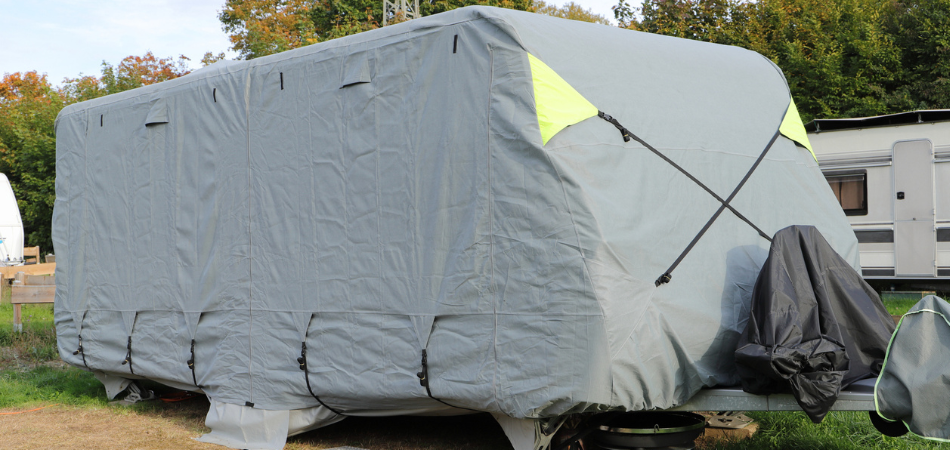Date Published: 2025/10/07
Read Time: mins
Avoid costly repairs: Essential tips for winterizing your RV

As the colder months approach across Canada, it's time to start thinking about storing your RV until the warmer weather of spring makes its welcome appearance. Properly winterizing your RV helps prevent costly damage and ensure it's road-ready when spring arrives. Here are some essential tips to help you get started.
Why winterizing your RV matters
Taking the time to winterize your RV is important for several reasons. Proper preparation can prevent issues such as burst plumbing pipes, dead batteries, and other costly problems that may arise when you try to use your RV again in the spring.
How to winterize your RV: Maintenance checklist
While this is not an exhaustive list, these maintenance tasks are a great starting point for most RVs. Always refer to your owner's manual for winterization steps specific to your RV.
- Flush and winterize your RV’s pipes
Water can be your RV's biggest enemy during winter. Any water that is left inside your RV's pipes will run the risk of freezing, which can cause cracks and other pipe damage that will create major headaches in the spring. One of the best things you can do to protect your RV this winter, then, is to winterize your plumbing.
- Protect your RV's exterior
Before storing your RV, wash it thoroughly and apply a quality wax to protect the exterior. If you use a cover, ensure it is breathable to prevent moisture buildup, which can cause damage.
- Cover your wheels
Prolonged exposure to extreme temperatures and UV rays can damage your RV's wheels. Cover them while in storage and check the tire pressure in the spring, as they may deflate over the winter.
- Remove and store your batteries
To avoid dead batteries, remove them from your RV and store them in a warm, dry place. Turn off all breaker switches before removing the batteries. Check their charge periodically and recharge if necessary.
- Remove your AC filters
Clean or replace your RV's air conditioning filters before winter. This will save you time and effort when you prepare your RV for use in the spring.
- Inspect your roof and seals
Check the roof and seals of your RV for any cracks or damage. Repair any issues to prevent leaks and water damage during the winter months.
- Clean and empty your refrigerator
Clean out your RV's refrigerator and leave the door slightly open to prevent mold and odors. Place a box of baking soda inside to absorb any remaining odors.
- Use moisture absorbers
Place moisture absorbers or dehumidifiers inside your RV to prevent mold and mildew. This is especially important if your RV will be stored in a humid environment.
- Check and lubricate your RV’s moving parts
Inspect and lubricate all moving parts, such as hinges, locks, and slide-outs. This will ensure they remain in good working condition and prevent rust.
- Secure and store your valuables
Remove any valuables from your RV and store them in a safe place. This includes electronics, important documents, and personal items.
- Check your tire pressure
Ensure your RV's tires are properly inflated before storage. This will help prevent flat spots and ensure they are ready for use in the spring.
- Disconnect your propane tanks
Turn off and disconnect propane tanks to prevent leaks and potential hazards. Store them in a safe, ventilated area.
Have more questions about winterizing your RV? Our experts are here to help. Meet Amy, our RV insurance expert.
Additional tips for newer RV models
Newer RV models often come with advanced features and technology that require special attention during winterization:
- Check for smart systems: Many newer RVs have smart systems that control various functions. Ensure these systems are properly shut down and protected from the cold.
- Inspect seals and gaskets: Newer RVs may have more complex seals and gaskets. Inspect these for any signs of wear and replace them if necessary to prevent leaks.
- Battery management systems: If your RV has a battery management system, follow the manufacturer's guidelines for winter storage to maintain battery health.
Additional tips for older RV models
Older RV models may require extra care to ensure they remain in good condition over the winter:
- Inspect for rust and corrosion: Older RVs are more susceptible to rust and corrosion. Check the undercarriage and other vulnerable areas and treat any rust spots to prevent further damage.
- Upgrade insulation: If your RV is older, consider adding extra insulation to keep it protected from the cold. This can help prevent freezing pipes and other issues.
- Check electrical systems: Older electrical systems may need more frequent inspections. Ensure all wiring is in good condition and replace any damaged components.
Additional tips for RVs stored outdoors
Storing your RV outdoors requires extra precautions to protect it from the elements:
- Use a high-quality cover: Invest in a high-quality, breathable cover designed for your RV model. This will protect it from snow, ice, and UV rays while preventing moisture buildup.
- Elevate your RV: If possible, elevate your RV on blocks to keep the tires off the ground. This can prevent flat spots and reduce exposure to moisture.
- Seal openings: Ensure all openings, such as vents and windows, are sealed tightly to prevent pests and moisture from entering.
- Clear snow and ice: Regularly clear snow and ice from the roof and around the RV to prevent damage and ensure proper ventilation.
Properly winterizing your RV will save you time and money when the warmer weather returns. Follow these maintenance steps to ensure your RV is ready for your next adventure. Want peace of mind while your RV is in storage? Request a quote today and protect your investment throughout the year.